When you live abroad for long periods of time, you get accustomed to certain foods which, returning home, you can’t find anywhere, and the sense of a habit unwillingly broken is acute. If the foreign country is Thailand or Italy, you stand a good chance of finding dishes approximate to those you’ve left behind in a local restaurant. But if your working life has been spent in the countries of Central and Eastern Europe, and you live well outside London, you must learn to make them for yourself or do without.
In the warm hotel restaurant, after freshly brewed black coffee, I was given a glass of heated honey vodka
The first foreign country I lived in was Estonia. Estonian food at that time (maybe it has changed) tended to be simple and subtle – I remember roast pork, endless varieties of sausages, milk curds and gently spiced cakes. All this was pleasant and wholesome enough, with often bracingly fresh ingredients – Estonians are great ones for having an extensive kitchen garden, and often bee-keep as well – but rather unexciting to the palate of an Englishman, who’d grown up on such food. During the Soviet period, though, several Russian dishes had become popular, and probably the best of these – and the one easiest to find on restaurant menus – was seljanka soup.
This was a new taste for most westerners – a soup made with boiled meat, sausage, gherkins, meat stock and rassol (the salt water the gherkins are preserved in). It had a wonderfully tangy taste to it, was dense with slices of pickled cucumber and frankfurter, and its sourness was offset by a dollop of cold sour cream (always tastier if you didn’t stir it into the soup too much). You ate all this with slices of unbuttered black bread, almost rubbery in texture, and extremely filling. If, to accompany it all, you had mineral water from the Caucasus (Narzan and Borzhomi are two popular brands) and a glass or two of ice cold vodka, you felt a simple lunch in Eastern Europe couldn’t get much better.
When I moved to Russia 20 or so years later, it wasn’t seljanka but pelmeni I ate several times a week. These were little meat dumplings, a kind of disc-shaped, sauceless ravioli which rarely disappointed. So habitual are these out east that, along with the freezers full of different brands of them to be found in shops, most Russian markets also sell pelmeni moulds, iron contraptions with round or hexagonal windows in them for pressing the pastry through. There were endless varieties of pelmeni – domashnie with beef and pork, ‘Caucasian’ ones with lamb added as well, ‘Cossack’ with chicken and mushrooms and even, in some restaurants, pelmeni filled with duck or prawns. All would usually come slathered in smetana (sour cream) and festooned with fresh parsley and dill. They were as moreish as Maltesers, and you could never have enough of them. The technique of making them, though – second nature to most babushkas – requires a dexterity of finger-work I will never possess, and since leaving Russia in March 2022, I’ve had to do without them. Missed too are sirniki, little hot cakes of milk curd best served with blackcurrant jam and kvass, a summer drink of sweet, fermented rye bread sold on many Russian street corners from beer taps.
When it comes to politics, life in Eastern Europe may still be a case of ‘Moscow Rules’ (whether one is swimming with the tide or against it) but this doesn’t really apply in cooking, and many of the best dishes I’ve had in the region have been from well outside Russia. In Telc, a picturesque, lakeside Czech town I ate svíčková, beef tenderloin under a herby cream sauce, served with cranberry jelly and hot bread dumplings. In Prague I had a half-duck almost falling off the bone, roasted a deep mahogany with scattered caraway seeds and served with hot sauerkraut and a jug of gravy-ish sauce. In Poland there is a white soup, bialy barszcz, a mixture of vegetables, horseradish and sour cream, into which sausage is sliced thickly and which is topped off with halves of boiled egg. It’s a taste – again, pleasantly sour and provocative – you acquire quickly (and some watered down version can probably be bought from most Polish shops in England).
None of this is to mention Hungary, probably the culinary superpower of Central Europe, where there are almost too many good dishes to list: goulash, paprikás csirke (chicken in a sour cream and paprika sauce, with noodles), Jókai-bableves, a thick, meaty bean soup, and Dobos torte (a 12-layered sponge cake with a hard, crackable caramel top to it, a confection which has become a kind of Hungarian monument and given rise to national festivals). Hungarian cuisine takes sweet as seriously as savoury, and one of the best desserts in this country is somlói galuska, a lavish kind of trifle involving three different sponges, raisins, walnuts, chocolate, whipped cream and rum. It is, of course, to be eaten in very small quantities, but is representative of the richness, almost the decadence, in which Hungarian food specialises. But where are the Hungarian restaurants in the UK, now that the Gay Hussar has closed?
Context, of course, is everything. One of the most memorable meals I ever ate in Eastern Europe was also one of the simplest, in a Soviet-era hotel near Krakow station – a dish of cabbage rolls stuffed with meat, served under a wild mushroom sauce and accompanied by rough-cut, perfectly fried potatoes. In the warm hotel restaurant, after freshly brewed black coffee, I was given a glass of heated honey vodka as a digestif. The sky was overcast outside, the atmosphere pleasantly melancholy, and all you could hear, between recordings of Chopin waltzes, was the far-off rumble of trains bound for Warsaw and Gdansk. If you can’t see how perfect all this was, then Eastern Europe, and its cooking, are probably not for you.








Comments